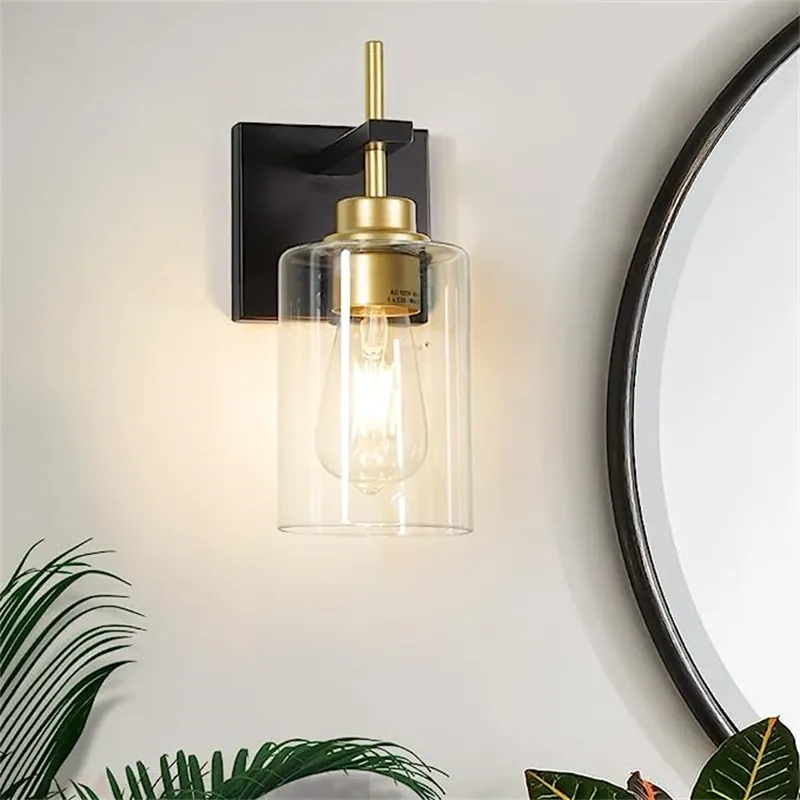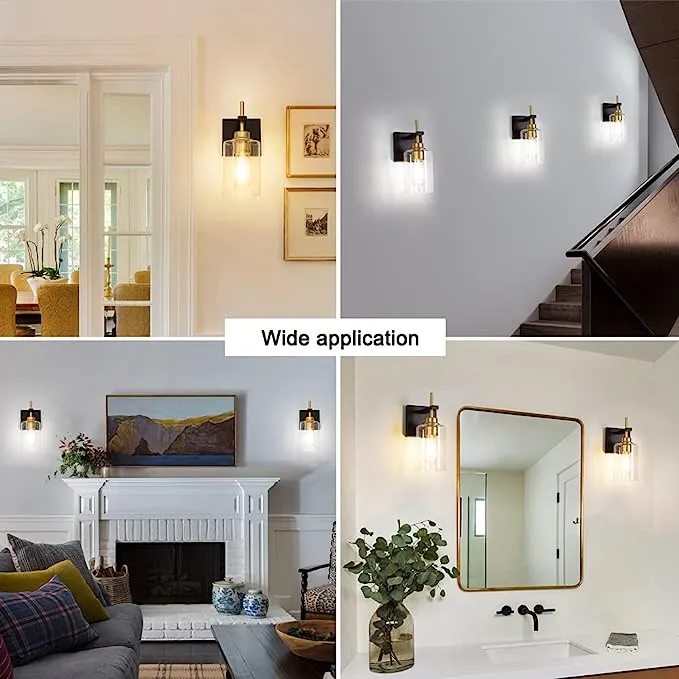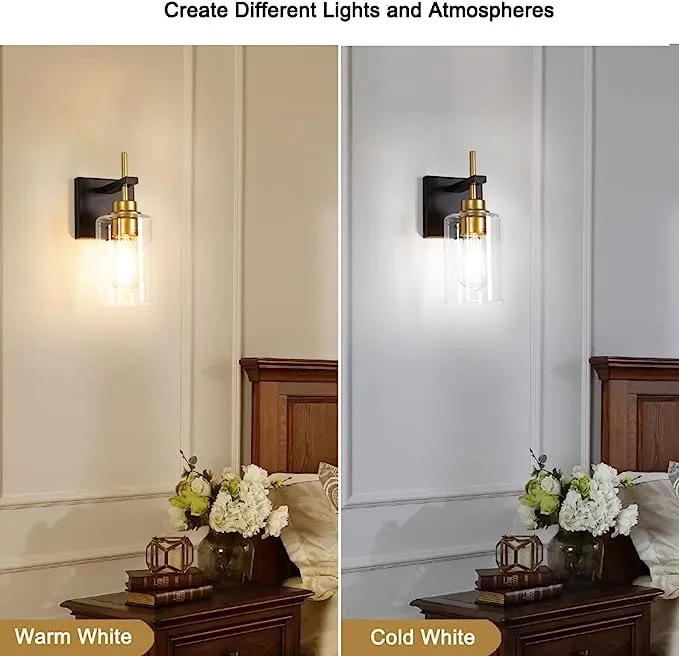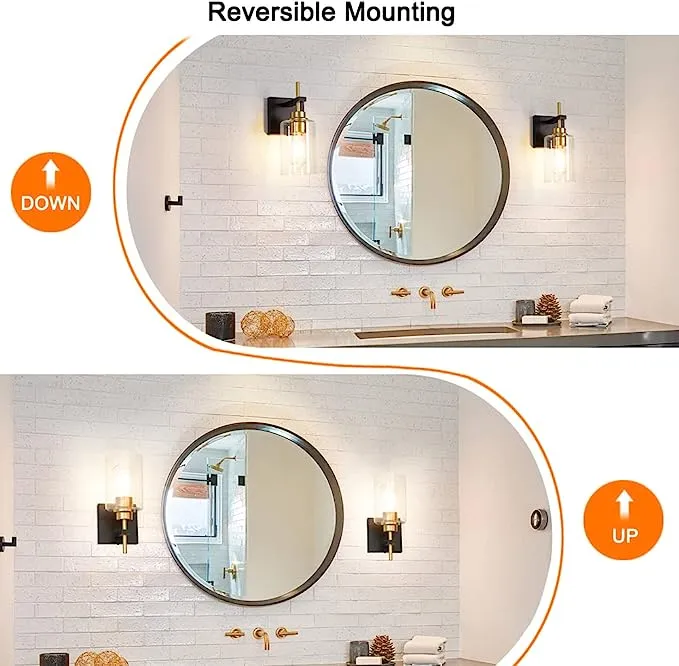How many wall lights are needed for a bathroom vanity?
In modern home lighting planning, the bathroom vanity area is often a key focus. Whether washing, applying makeup, or grooming, proper lighting directly impacts the overall experience and effectiveness.
A common question is: How many wall lights are needed for a bathroom vanity? A professional answer requires a deep understanding of vanity wall lights and the application of scientific design principles.
This article will systematically explain the role of vanity wall lights, the professional calculation basis for installation quantity, layout methods, lighting parameters, environmental compatibility, and safety considerations, providing readers with a comprehensive reference.

How many wall lights are needed for a bathroom vanity?
When consumers plan their bathroom lighting, a common question they ask is: "How many wall lights do I need for my bathroom vanity?" The answer isn't a single one; it depends on multiple factors, including mirror size, number of users, space size, optical requirements, and moisture-proofing and safety requirements. Regardless of changing conditions, one thing is certain: ideal bathroom vanity lighting depends on the strategic placement of vanity wall lights.
Why are bathroom vanity lights essential?
Before answering the question, "How many are needed?", we must first understand the importance of vanity wall lights.
1. The Need for Uniform Illumination
The main bathroom ceiling light is often installed in the center of the ceiling, with a downward angle, which can easily create shadows. When standing in front of a vanity mirror, areas like the bridge of the nose and eye sockets are obscured, resulting in uneven lighting on the face. This is detrimental to delicate tasks like applying makeup, shaving, or skincare.
2. Reducing Glare and Shadows
Vanity wall lights are typically installed at face height, providing soft light from the front or side, effectively avoiding harsh shadows cast by overhead light sources and improving lighting comfort.
3. Decorative and Ambiance Creation
Beyond practicality, vanity wall lights also serve as an aesthetic design element. Whether arranged symmetrically or installed in multiple locations, they can enhance the sense of depth and overall style of the bathroom space.
Thus, wall lights aren't optional; they're essential components of bathroom vanity lighting design.

What Determines the Number of Vanity Wall Lights? — Key Factors
How many wall lights are needed for a bathroom vanity? This question should be answered from the following perspectives:
1. Mirror Size
• Small single-person mirrors (40–60 cm wide): A single vanity wall light in the center is sufficient.
• Medium mirrors (60–100 cm wide): It's generally recommended to install a vanity wall light on each side to create a symmetrical light source.
• Large double mirrors or extra-wide mirrors (over 100 cm wide): Wall lights should be installed on both sides, while one or more vanity wall lights should be added in the center or above the mirror to ensure full illumination.
2. Number of Users
• For a single person: One or two vanity wall lights are sufficient.
• For two people using the bathroom simultaneously: We recommend at least three vanity wall lights, typically on both sides and one above, to ensure adequate facial illumination for each user.
3. Spatial Lighting
• If the bathroom already has strong overall lighting, the number of vanity wall lights can be reduced.
• If the overall lighting is weak, additional vanity wall lights may be needed to supplement local illumination.
4. Optical Requirements
• For those who prioritize makeup and grooming, a symmetrical layout should be chosen, with an appropriate number of vanity wall lights to minimize shadows and color shifts.

Common Configuration Patterns: Quantity and Layout
In bathroom vanity design, the following are common vanity wall light quantity and layout options:
1. Single Wall Light
• Suitable for: Small bathrooms, single narrow mirrors.
• Placement: Installed in the center above the mirror.
• Advantages: Saves space and costs.
• Disadvantages: The light source primarily comes from above, which can easily create shadows on the face.
2. Dual Wall Light Pattern (Symmetrical)
• Suitable for: Medium-width mirrors.
• Placement: Install a vanity wall light on each side of the mirror, with the center of the light source near eye level.
• Advantages: Provides even illumination, best conforms to professional lighting principles.
• Disadvantages: Requires ample wall space.
3. Triple Wall Light Pattern (Two Sides + Top)
• Suitable for: Large mirrors or double vanities.
• Placement: One lamp on each side of the mirror and one above it.
• Advantages: Creates surround light, minimizing shadows.
• Disadvantages: Complex installation, slightly higher power and energy consumption.
4. Multi-Point Wall Light Pattern (Four or More)
• Suitable for: Extra-wide mirrors or professional powder room-style bathrooms.
• Placement: Two lamps on each side of the mirror, or symmetrically with multiple overhead fill lights.
• Advantages: Highly uniform illumination, suitable for meticulous makeup application.
• Disadvantages: High cost, requiring professional wiring and installation.
The impact of lighting parameters on quantity selection
1. Illuminance
According to indoor lighting standards, facial illumination in the dressing area should reach 500–1000 lx. If a single vanity wall light cannot meet this illumination, additional vanity wall lights should be used to compensate.
2. Color Temperature (CCT)
A range of 2700K–4000K is generally recommended. When increasing the number of vanity wall lights, ensure that all vanity wall lights have a consistent color temperature to avoid uneven skin tones.
3. Color Rendering Index (CRI)
Select a light source with an Ra ≥ 90. If using a large number of vanity wall lights, ensure that all vanity wall lights have consistent color rendering; otherwise, localized color variations may occur.
4. Beam Angle and Distribution
Narrower beam angles result in concentrated illumination but less uniformity, requiring more fixtures. Wider beam angles provide greater coverage, requiring fewer fixtures.

The Impact of Bathroom Environment Characteristics on the Number of Wall Lights
Bathrooms differ from bedrooms or powder rooms in that they have higher humidity and safety requirements, which in turn influence the number and layout of vanity wall lights:
1. IP Rating
For bathrooms, it is recommended to choose vanity wall lights rated IP44 or higher to ensure splash protection. As the number of fixtures increases, ensure that each fixture meets the IP rating requirements.
2. Humidity and Reflection
The strong reflective properties of bathroom tiles and mirrors can cause excessive glare. Distributing multiple vanity wall lights can reduce single-point brightness and improve comfort.
3. Electrical Safety and Installation
Each additional vanity wall light creates additional electrical connections. Installation must be performed by a professional to ensure grounding, moisture resistance, and electrical shock protection.
Recommended Quantities for Different Spaces
• Small Bathrooms (Mirror Width ≤ 60cm): One Vanity Wall Light is recommended, mounted above.
• Standard Bathrooms (Mirror Width 60–100cm): Two Vanity Wall Lights are recommended, mounted symmetrically on both sides.
• Double Bathrooms (Mirror Width 100–150cm): Three Vanity Wall Lights are recommended, one on each side and one above.
• Luxury Bathrooms (Mirror Width ≥ 150cm): Four or more Vanity Wall Lights are recommended, distributed on both sides or above and below.
Safety and Maintenance: Considerations for Increasing the Number of Vanity Wall Lights
• Wiring Safety: Multiple vanity wall lights require proper circuit distribution to avoid overload.
• Dimming Consistency: When increasing the number of vanity wall lights, it is best to use a unified dimming control to avoid varying brightness levels among the vanity wall lights.
• Maintenance Ease: Installing too many vanity lights increases the difficulty of subsequent replacement and cleaning, so a balance should be struck between quantity and convenience.
Bathroom Vanity - Scientifically Determine "How Many Wall Lights Are Needed"
In summary, there's no single answer to the question, "How many wall lights are needed for a bathroom vanity?" Instead, a scientific assessment should be made based on the mirror width, space size, usage requirements, lighting specifications, and protection level.
1. For most homes, two vanity wall lights symmetrically installed on either side of the mirror are the most professional and balanced choice.
2. For more demanding users, three or more vanity wall lights can be added to create a surround lighting system.
3. For bathrooms with limited space, a small mirror can be paired with just one vanity wall light.
In any case, choosing the right number of vanity lights, implementing a strategic layout, and adhering to electrical safety regulations are fundamental to ensuring a comfortable and safe bathroom vanity area.
What kind of LED products do you manufacture?
Huari Lighting manufactures a complete line of LED night lights, cabinet lamps, vanity wall lighting, downlights, track lights, and panel lamps. Established in 1996, our company integrates R&D, production, and global sales. As a professional LED factory in China, we provide wholesale supply at affordable prices without sacrificing quality.
Buyers can request free quotes for bulk purchasing, explore seasonal promotions, and enjoy discounts on customized designs. Our brand stands for reliability, efficiency, and long-term partnerships.
